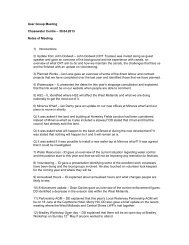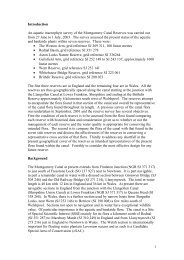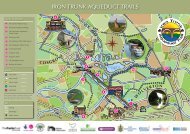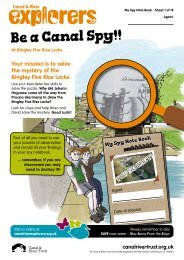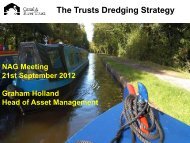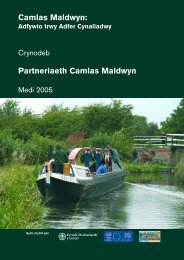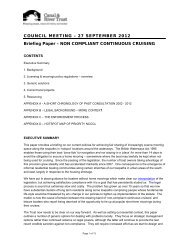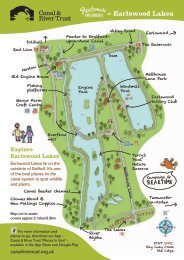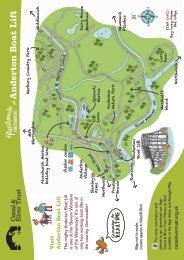Montgomery Canal Conservation Management Strategy (1.2MB PDF)
Montgomery Canal Conservation Management Strategy (1.2MB PDF)
Montgomery Canal Conservation Management Strategy (1.2MB PDF)
You also want an ePaper? Increase the reach of your titles
YUMPU automatically turns print PDFs into web optimized ePapers that Google loves.
30) <strong>Management</strong> will be by careful machine trimming, supplemented by a programme of hedge-laying, and retention<br />
of standard trees. In suitable locations a taller hedge or woodland fringe will be allowed to develop.<br />
Length specific proposals will be incorporated into maintenance plans and procedures.<br />
31) Summer towpath mowing will be confined to a central walking strip, in order to continue to promote species rich<br />
grass margins. Full cuts will be undertaken in late summer and early spring.<br />
32) Offside buffer zones will be encouraged, and used to develop wider marginal vegetation and new hedgerows or<br />
woodland strips.<br />
7.3.6 Managing Undesirable Species<br />
Aquatic habitats are prone to sudden infestation of introduced plant species such as Floating Pennywort and Water<br />
Fern.<br />
33) The canal will be regularly monitored by canal staff in the course of their normal work regime to enable a quick<br />
response to any occurrences of undesirable species.<br />
34) Steps to eliminate Japanese Knotweed along the canal will be taken, through a planned spraying programme.<br />
Elodea species are generally a sign of poor water quality, out-compete the ecologically valuable species, and are a<br />
major hindrance to navigation.<br />
35) Annual weed cutting of the canal will continue, and expand if necessary, with removal of cuttings. Steps to<br />
investigate better collection systems will be pursued.<br />
This will help remove nutrients from the system, and further optimise habitat conditions.<br />
Fish introductions will not be allowed. Partnership with local angling clubs will provide a mechanism for ensuring<br />
this. Measures to control mink will be reviewed if the water vole populations appear to be declining.<br />
7.3.7 The Wider Corridor<br />
It is a continuing theme of nature conservation in canals that management is seeking to protect a habitat that is both<br />
man-made, and subject to rapid ecological succession if unmanaged. Modern propeller craft are more damaging than<br />
the original horse-drawn traffic, and management is therefore often a compromise between conflicting aims. Looking<br />
to the wider canal corridor is an increasingly important way of addressing these issues. This is not to negate the value<br />
of the canal, or its protection, but does point a way forward for the long term development of a complementary<br />
strategy to seek to re-create suitable habitats for these species beyond the canal system.<br />
Creation of new off-line habitat areas is a start to this process, but it is pertinent to review a range of other initiatives<br />
in the local canal corridor, which have links to both this strategy and shared interests with the <strong>Montgomery</strong> <strong>Canal</strong><br />
Partnership. A summary of these schemes is given in Table 7.5.<br />
36) The <strong>Montgomery</strong> <strong>Canal</strong> Partnership will actively support wider environmental schemes which have shared or<br />
complementary objectives.<br />
107



